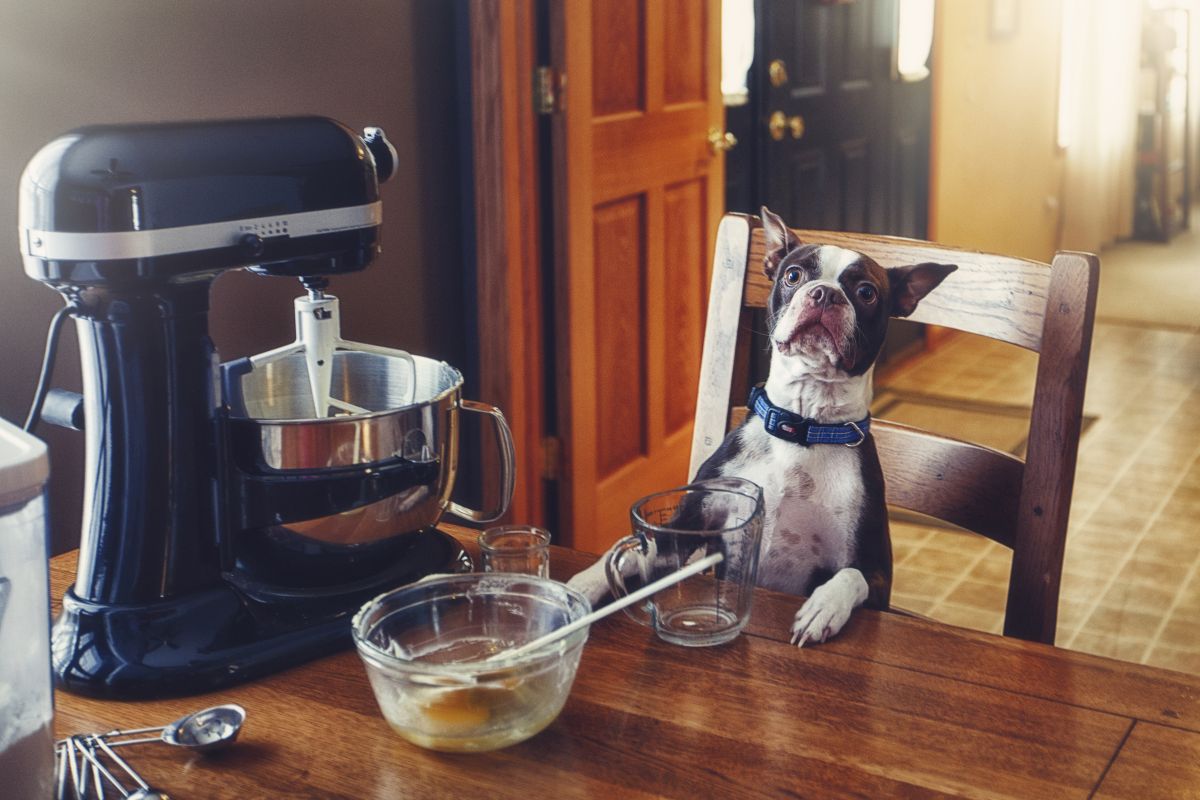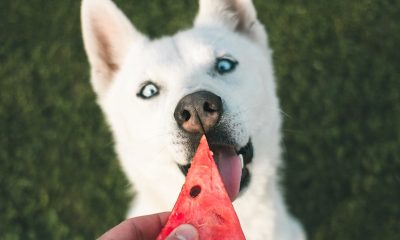Dog Food
All About Homemade Dog Food

Are you ready to go on a culinary journey to make the best homemade dog food your pooch has ever tasted? With this article, you’ll have all the tasty ingredients and recipes for DIY pup meals that will leave tails wagging faster than lightning.
It’s time to treat your furry friends with love – and healthy nutrition – like never before. Your pups will thank you when they taste just how delicious homemade doggy dishes can be. It’ll be so good that their tongues won’t know what hit ‘em.
Homemade dog food is one of the easiest ways to give your pet quality nutrition in every meal. You get control over exactly what goes into each dish, right down to the last ingredient.
Plus, DIY canine cuisine helps ensure only fresh, natural ingredients enter Fido’s bowl – no preservatives or additives allowed. That way, your pup gets a balanced diet full of vitamins and minerals while also enjoying scrumptious flavor combinations at mealtimes.
In this article, we’ll dive headfirst into all aspects of creating wholesome homemade food for dogs, from choosing proper ingredients to safety guidelines and yummy recipe ideas.
So, let’s get started by learning more about why switching up your pup’s regular chow might be beneficial for them in the long run!
1. Benefits Of Homemade Dog Food
A healthy and balanced diet for your pooch is a must! Not only does it provide them with all the essential nutrients their body needs to thrive, but also gives you peace of mind in knowing that they are getting the best nutrition possible. Homemade dog food has numerous benefits over commercially bought options.
Imagine fluffy Fido running around energetically as if he were a puppy again. It can be made from ingredients already present in your kitchen, so you have full control over what goes into his bowl, making sure there’s nothing artificial or unhealthy going down his throat.
You don’t need to worry about any hidden preservatives ruining his digestive system. Plus, when you make fresh meals at home, you know exactly where these ingredients come from and how safe they are for him – something that just isn’t possible with store-bought kibble.
It’s easy to see why homemade dog food is becoming increasingly popular among pet owners who care deeply about their furry companion’s health and well-being.
The additional effort required to prepare each meal might seem intimidating at first, but the reward is well worth it: an energetic pup filled with joy and life!
Now let’s discuss the essential nutrients needed for your pup’s diets, which will help you create even more nutritious meals for them!
2. Essential Nutrients For A Healthy Dog Diet
No one can deny the importance of nutrition when it comes to keeping our fur babies healthy and happy. Providing essential nutrients in their diet is key for a pup’s well-being, especially if you’re opting for homemade dog food.
When crafting your dog’s meal plan, there are three main things you need to consider: proteins, fats, and carbohydrates. These macronutrients form the basis of a balanced diet and should be present in all recipes prepared with love – yes, even when making doggy dinners.
Proteins provide energy to maintain strength while also supporting skin health; fats give them ample energy reserves as well as help keep bones strong; carbs guarantee they have enough fuel to stay on top of their game throughout the day.
Not only must each element mentioned above be taken into account, but other important minerals too such as calcium, phosphorus and magnesium—as well as vitamins like A & D—should not go overlooked either.
All these components play an integral role in keeping dogs fit and full of vigor while ensuring they don’t suffer from any nutritional deficiencies. With this knowledge firmly under your belt, you’ll easily be able to craft nutritious home-cooked meals for Fido that will make him feel energized every single day.
3. Types Of Ingredients For Homemade Dog Food
Making homemade dog food is like a recipe in progress – it takes time, patience, and the right ingredients. When you’re looking for types of ingredients to add to your pup’s meal plan, there are plenty that can provide essential nutrients without costing an arm and a leg.

Start by considering proteins such as lean turkey or chicken breast, lean ground beef, cuts of grass fed beef, egg whites, salmon, or tuna packed in water.
As far as carbohydrates go, cooked brown rice or oats are great options; sweet potatoes contain complex carbs along with vitamins A & C while adding flavor and texture to your pup’s dinner plate.
For fats, avocado oil has Omega-3 fatty acids, while olive oil contains monounsaturated fats, which help support healthy skin & coat. Plus both oils have anti-inflammatory properties too!
Since vegetables are at the top of the list when it comes to doggy nutrition basics (not to mention fiber!), start small with things like spinach (which provides antioxidants) or green beans (rich in Vitamin K).
Fruit should also be included occasionally – blueberries offer powerful antioxidants and are low in sugar. In contrast, apples can help freshen breath due to their natural tartar control properties. Your pet will appreciate these tasty additions!
So now that we’ve covered some key ingredient categories for homemade dog food recipes let’s move on to tips for preparing them safely…
4. Tips For Preparing Homemade Dog Food
Did you know that 8 out of 10 owners feed their dogs homemade food at least once a month? Making your own pet food is an excellent way to provide all the nutrients your pup needs. But how do you go about preparing it properly?
Here are some useful tips for making sure your homemade dog food is safe and nutritious for your fur baby.
First, make sure to include proteins like lean meats and grains such as rice or pasta in each meal. You can also add vegetables like carrots and potatoes, though be careful not to overdo it with starchy veggies.
Adding eggs, fish oil, and yogurt can help round out the nutrition profile. Ensure to cook everything thoroughly before serving so bacteria isn’t passed on to your pup!
You may also want to consider supplementing with vitamins and minerals; many pet stores carry special formulas designed specifically for canine consumption. If you’re unsure what type of supplements would best suit your pup’s dietary needs, consult a veterinarian who can provide further guidance.
5. Safety Precautions For Feeding Homemade Dog Food
When it comes to your pup’s health, making sure their food is safe for them should always be a top concern. Feeding homemade dog food can provide many benefits if done correctly and safety precautions need to be taken when preparing the meals.
Imagine your pet eagerly waiting for their mealtime, and you will feel accomplished knowing you are providing them with quality nutrition. The following list gives insight into important safety measures that need to be followed while feeding homemade dog food:
- Wash hands and all surfaces thoroughly before preparing the ingredients you choose
- Use human-grade meats, vegetables, and other ingredients free from preservatives or additives
- Make sure all items have been cooked properly before serving to avoid any potential bacterial contamination risks
Following these steps will help keep your furry friend healthy and happy during mealtime! Additionally, there are also ways to incorporate variety into their diets so they don’t become bored with eating the same thing over and over again.
6. Variety Of Recipes For Homemade Dog Food
When it comes to feeding your pup, variety is key. A well-rounded diet of homemade dog food can offer just that! With the right recipes and ingredients, you can provide a healthy balance for your furry friend. Here are some ways to incorporate more variety into their meals:
1) Experiment with different types of proteins. Offer up beef, chicken, lamb, fish or even eggs. This way, your pup won’t get bored with the same old thing daily.
2) Try out various grains and starches like brown rice or potatoes as an alternative to kibble. Get creative and explore other options, such as quinoa or sweet potato!
3) Incorporate fresh produce into their meal plan by chopping up greens like spinach or carrots and adding them in. This will give them extra vitamins and minerals they need while also providing additional flavor.
4) Don’t forget about fiber! Adding oats or beans helps digestion and keeps things running smoothly in their digestive system. Plus, these ingredients add bulk so they feel fuller longer after eating, which can help with weight management.
Making sure your pup gets enough variety in his diet doesn’t have to be hard work – with a few simple steps, you’ll have a tailored menu for them in no time! Now let’s look at the pros and cons of making this switch…
7. Pros And Cons Of Homemade Dog Food
Preparing homemade dog food for your pup offers several distinct advantages and drawbacks that pet owners need to consider. Crafting canine cuisine with canines in mind can bring both benefits and burdens.
Beginning with the blessings of a homemade diet, many precious pooches may prefer palatable plates made from fresh ingredients. Furthermore, feeding Fido fare fashioned from scratch provides pet parents peace of mind as they know what goes into their pup’s plate.
Crafting custom kibble allows appropriate adjustments for any medical needs or special dietary requirements that store-bought meals may not meet.
However, cooking for canines requires considerable commitment from proprietors; devising delightful dishes demands dedication and time investment. Moreover, if recipe instructions are not followed precisely, potential problems like vitamin deficiencies and nutrient inadequacies could arise.
In addition, obtaining all the necessary components plus additional supplements might be expensive since some items may only be available online or at specialty stores. With these pros and cons in mind, now is an opportune moment to investigate cost-effectiveness when considering homemade dog food options.
8. Cost-Effectiveness Of Homemade Dog Food
The cost-effectiveness of homemade dog food can be an issue for many pet owners. As with anything else, the ingredients used to make a home-cooked meal for your pup have costs associated with them. So, how do you decide if this type of diet is right for your wallet?
On one hand, making food at home offers more control and customization than buying pre-made meals. You know exactly what goes into each dish and are able to adjust it according to your budget.
This means that you may save money in the long run by only purchasing certain items when they’re on sale or using cheaper substitutes for some of the pricier ingredients.
Plus, making multiple batches in advance and freezing them can help reduce waste and give you peace of mind, knowing there’s always something nutritious available for your furry friend!
Still, just like humans need balanced diets, so do our four-legged family members. While it’s tempting to try to cut corners here, doing so could lead to nutritional deficiencies that will eventually catch up with us (and our wallets).
It’s important to consult with a vet before changing any existing diet routine – ensuring that all essential vitamins and minerals are included is not only beneficial but also necessary.
To ensure cost-effectiveness, consider supplementing commercial foods as needed while still providing quality nutrition through home-cooking recipes.
Ultimately, investing time in researching both store-bought options as well as homemade dishes can provide insight into which option best fits both Fido’s needs as well as ours financially.
With proper planning and knowledge, we’ll be able to find the solution that works best for everyone involved – including our wallets! Taking these considerations into account makes storage and preservation of homemade dog food much easier, too.
9. Storage And Preservation Of Homemade Dog Food
Storing and preserving homemade dog food can be a tricky process. According to the American Pet Products Association (APPA), it’s estimated that Americans spent $95 billion dollars on their pets in 2020 alone, so making sure we take care of our best friends is important.
It’s essential to know what ingredients you need for your pet’s meal, as well as understand how long they will last before spoiling or needing to be thrown out.
The first step in storage is keeping all ingredients fresh and free from contamination or bacteria growth. To do this, keep them in airtight containers with labels describing when each item was made, if possible. This ensures that anything added to the mixture has not gone bad prior to being used for cooking.
Create an inventory system of sorts by writing down what each container holds and updating it regularly. Doing so makes it easier to identify which items are running low and must be replenished soon.
Another key factor is refrigeration. Homemade meals should always go in the fridge after cooling off because some foods spoil quickly at room temperature while others freeze well over time – such as meat-based dishes like beef stew – depending on the recipe ingredients used.
If freezing isn’t an option due to space limitations, consider dividing portions accordingly and placing them in individual zip bags; then, store those individually inside one larger bag that can easily fit into the freezer compartment of your refrigerator.
Having a good handle on storing and preserving homemade dog food is critical to providing our furry companions with safe nutrition options without having to worry about potential risks associated with spoiled food consumption.
In order to make sure all stored batches remain within optimal safety standards, regular inspections should be done along with the proper labeling techniques mentioned earlier for maximum efficiency when tracking expiration dates.
With these tips under consideration, let us now explore viable alternatives for preparing nutritious meals for our beloved pups.
10. Alternatives To Homemade Dog Food
A homemade dog food diet is like a blank canvas – it has the potential to be anything you want. With all its ingredients and recipes, there’s an infinite possibility of creative combinations that can help your pup thrive.
But while this type of meal plan offers many advantages, sometimes alternatives may be necessary.
The first option would be store-bought food. Many brands have nutritional profiles tailored for specific breeds or ages, which makes them suitable options if you don’t have the time or resources to cook fresh meals every day.
However, some commercial products contain preservatives and artificial additives, so read labels carefully before making any purchases.
Another alternative could be raw diets – these consist mainly of uncooked meats supplemented with vegetables and fruits. This type of meal plan gives pups access to more natural sources of protein than processed foods do.
Just remember that they still need nutrients such as calcium and vitamins found in cooked grains or legumes, so add those into their daily intake. Finally, treats should also be taken into consideration since they are important for dogs’ overall health, too.
Homemade dog food provides many benefits, but alternatives exist when needed. Store-bought food can provide convenience, while raw diets offer more natural forms of nutrition – however both require additional supplements depending on your pet’s needs.
Treats are also part of a healthy canine diet; don’t go overboard with them. All these considerations will ensure your furry friend receives optimal nourishment throughout his life journey with you.
Start Adding Homemade Dog Food To Your Pup’s Diet Today!
It’s clear that homemade dog food can be a great way to provide your pup with healthy, nutritious meals. Pet owners need to research and understand the proper amount to feed their dogs, as well as how often they should feed them.
Puppies also require special consideration when it comes to homemade diets, so consulting a veterinarian will help ensure puppies are getting all of their nutritional needs met.
When making homemade dog food, it’s essential to know which foods may cause harm or allergic reactions in pets.
Storing homemade food properly is an important step in keeping your dog safe and healthy. It’s like protecting a precious diamond—you want to keep it secure.
Overall, feeding your furry friend homemade recipes has many benefits. From providing wholesome nutrition to saving money on commercial products, crafting custom dishes for Fido can be an enjoyable experience.
Just remember: always consult with a vet before introducing any new diet changes into your pup’s routine.
Frequently Asked Questions
How Much Homemade Dog Food Should I Feed My Dog?
If you’re preparing homemade dog food, there are some guidelines to follow in order to ensure that your furry friend gets all the vitamins and minerals they need without overfeeding them. Generally speaking, an adult dog should receive between two-thirds and three-quarters of a cup of dry food or one cup of canned food each day. If this amount doesn’t seem like enough, consider adding fresh fruits and vegetables as well as cooked lean meats like chicken or fish for added protein. Keep portion sizes small so that you don’t exceed the recommended daily allowance.
It’s always best to consult with your veterinarian before making any changes in what you feed your dog.
How Often Should I Feed My Dog Homemade Dog Food?
Generally speaking, adult dogs require two servings per day, while puppies need three meals a day until they reach adulthood. As always, though, check with a veterinarian if you’re unsure about any aspect of your pooch’s diet and health needs, as individual circumstances will vary.
Is Homemade Dog Food Suitable For Puppies?
Puppies need higher levels of certain nutrients than older dogs do. They also require more calories per pound than adult dogs due to their rapid growth rate and activity level – especially active breeds. To make sure that they’re getting adequate amounts of all these vital components, you’ll want to check with your vet about what ingredients should go into each meal.
It’s also wise to discuss portion sizes and frequency when feeding homemade meals to your pup. Depending on the age of your puppy and their size, how often they eat will vary significantly from an adult dog’s schedule. Make sure you know exactly how much food your pup needs and how frequently they should be eating so that you don’t over- or under-feed them.
How Long Can Homemade Dog Food Be Stored?
Most homemade meals can last up to 3 days refrigerated and up to 4 months frozen. Generally speaking, if you follow proper safety guidelines when preparing and storing home-cooked meals, they should maintain their original nutrient content without spoiling until these timeframes have passed.
Are There Any Foods I Should Avoid When Preparing Homemade Dog Food?
The truth is that certain types of human food can actually do more harm than good if given to dogs in large quantities or too frequently. Foods like onions, grapes, raisins, garlic, chives, macadamia nuts and avocados should never be fed to a canine companion as they can cause serious health problems due to their toxicity levels. Chocolate contains caffeine and theobromine which can lead to seizures and other dangerous consequences when ingested by dogs.

-

 Health Issues3 years ago
Health Issues3 years agoWhat Is Canine Chronic Bronchitis?
-

 Health Issues3 years ago
Health Issues3 years agoHow to Keep Your Dog Active and Fit
-

 Health Issues3 years ago
Health Issues3 years agoIdentifying and Treating Parasites in Dogs
-

 Dog Food3 years ago
Dog Food3 years agoWhy You Need To Know How to Read Dog Food Labels
-

 Dog Food3 years ago
Dog Food3 years agoIdentifying And Treating Dog Food Allergies
-

 Health Issues3 years ago
Health Issues3 years agoCommon Dog Health Issues and Their Symptoms
-

 Dog Training3 years ago
Dog Training3 years agoUsing Treats Effectively When Dog Training
-

 Health Issues2 years ago
Health Issues2 years agoCommon Digestive Problems in Dogs and How to Address Them






























































